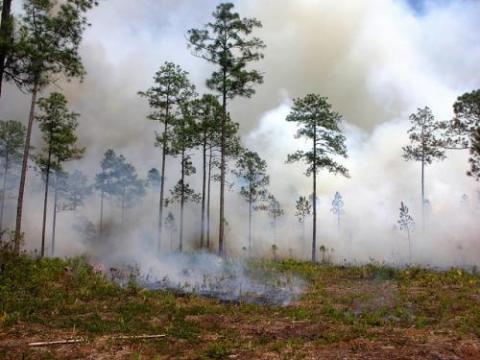
The Southeast Regional Partnership for Planning and Sustainability (SERPPAS) is a collaboration among federal and state agencies working to promote sustainable resource-use decisions and improve interagency management coordination in North Carolina, South Carolina, Georgia, Alabama, and Florida. Wildfire mitigation and improvement of wildlife habitat for listed species is of increasing importance within these management decisions and—with almost 90% of the southeastern United States under private ownership—targeted outreach to private landowners around fuels reduction and prescribed burning practices has been a significant priority.
Under the Southeast Prescribed Fire Initiative, SERPPAS partners use different methods to increase the use of prescribed fire by landowners—whether through outreach and education, encouraging best smoke management practices, or increasing capacity at a local level. Targeted communication with landowners is especially important, as comfort levels with prescribed fire vary greatly: some landowners require an introduction to the importance and benefits of prescribed burning on a landscape, while others are aware of the benefits of burning but require technical assistance in order to take action. Coordination, timing, and targeting of prescribed fire messages demand careful attention to public perceptions of wildfire risk and preferred channels for information sharing (see Partners in Fire Education’s The Language of Fire presentation here).
Jennifer (Jenn) Evans Fawcett, who works for North Carolina State University’s Extension Forestry program, focuses on the outreach and education component of the Southeast Prescribed Fire Initiative. Jenn highlights the importance of interagency collaboration and relationship-building at the local level when working with landowners, as well as providing a mix of written materials and hands-on experiences to promote understanding and action. Hands-on experience often comes in the form of field days which provide landowners with both information about prescribed burning and the resources to take next steps.
Jenn describes these field days as catering to different landowner typologies. Woodland Retreat-types, who often have less experience with management activities, can attend a classroom session followed by a visit to a site that has been burned in order to understand the impact of prescribed burning and its potential benefits. Working the Land-types often need less education and instead require technical assistance and information about liability, and so a field day targeted to  these landowners may include information on professional services available, state prescribed burn laws, and hands-on demonstrations of or opportunities to participate in the burning process. Field days like these allow local partners to move landowners along the Persuasion Slide, working with a landowner’s knowledge of the importance of prescribed burning and helping them to overcome perceived barriers, such as risk and liability.
these landowners may include information on professional services available, state prescribed burn laws, and hands-on demonstrations of or opportunities to participate in the burning process. Field days like these allow local partners to move landowners along the Persuasion Slide, working with a landowner’s knowledge of the importance of prescribed burning and helping them to overcome perceived barriers, such as risk and liability.
Landowners who attend field days (which can range from 15 to 100 participants, depending on the content) complete a program evaluation at the end of the workshop, but Jenn is working with partners to create a follow-up survey to understand whether landowners are taking action after attending field days in 2014, 2015 and 2016. In addition, staff plan on continuing targeted outreach efforts throughout the Southeast in order to reach even more landowners with messages about prescribed burning. “We know who’s attending our events, who’s active and interested, but we want to find out who’s not coming to our events and get them involved,” says Jenn. “We need to bring more people to the table.”
Slide diagram based on content from neurosciencemarketing.org.